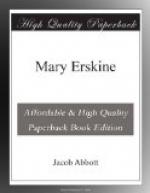[Footnote A: See Frontispiece.]
It was, however, only a few occasional hours of recreation that Mary Erskine devoted to ornamenting her dwelling. The main portion of her time and attention was devoted to such industrial pursuits as were most available in bringing in the means of support for herself and her children, so as to leave untouched the income from her house and her bridge shares. This income, as fast as it was paid in, she deposited with Mr. Keep, to be lent out on interest, until a sufficient sum was thus accumulated to make a new investment of a permanent character. When the sum at length amounted to two hundred and twenty dollars, she bought two more bridge shares with it, and from that time forward she received dividends on six shares instead of four; that is, she received thirty dollars every six months, instead of twenty, as before.
One reason why Mary Erskine invested her money in a house and in a bridge, instead of lending it out at interest, was that by so doing, her property was before her in a visible form, and she could take a constant pleasure in seeing it. Whenever she went to the village she enjoyed seeing her house, which she kept in a complete state of repair, and which she had ornamented with shrubbery and trees, so that it was a very agreeable object to look upon of itself, independently of the pleasure of ownership. In the same manner she liked to see the bridge, and think when teams and people were passing over it, that a part of all the toll which they paid, would, in the end, come to her. She thus took the same kind of pleasure in having purchased a house, and shares in a bridge, that any lady in a city would take in an expensive new carpet, or a rosewood piano, which would cost about the same sum; and then she had all the profit, in the shape of the annual income, besides.




